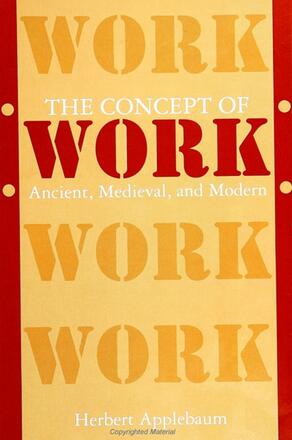
The Concept of Work
Ancient, Medieval, and Modern
Alternative formats available from:
Description
This book presents an analysis amd review of work, starting with the Homeric period, then dealing with classical Greece and classical Rome, the early Christians and Jews, the early Middle Ages, the era of Charlemagne, the high Middle Ages, the views of Luther and Calvin, the English and French Enlightenment, the nineteenth century, the twentieth century, and prospects for the future of work. It offers a rich and varied tapestry on the complexity of values regarding work, criss-crossing through crafts, occupations and professions, through slave and free-born employments, through lay and religious figures, and through rural and urban contexts. The permutations of work and its meanings are traced and related to the social and cultural contexts of each period of history dealt with — ancient, medieval, and modern.
Applebaum offers projections for work in the future, based on modern-day technologies, along with work within the context of new social conditions created by industrial cultures in the modern period. The future of work is examined as one of the key elements for the possibility of change in the social structure of industrial cultures. At a time when so many people are questioning the work ethic, this book provides a valuable perspective on work in past societies, how it has developed and been transformed, and what are its prospects for the future.
Herbert Applebaum is Director of Commercial Construction at Hartz Mountain Industries and former editor of the Anthropology of Work Review. He is the author of Work in Market and Industrial Societies and Perspectives in Cultural Anthropology, both published by SUNY Press, and Royal Blue: The Culture of Construction Workers and Work in Non-Market Societies.
Reviews
"This book focuses throughout on one theme: how work was regarded throughout the history of western civilization. In focusing on this theme, the author touches on very basic issues in sociology and social science form complex organization, to gender stratification, social stratification, and the sociology of religion. But these underlying issues are never allowed to divert the reader's attention form the main focus of the work. This singular focus makes the book an extremely important contribution. " — Kevin T. Leicht, Pennsylvania State University
"This book gives us both the conditions of work at particular times and the concepts of work expressed in the contemporaneous writing of major figures. Thus, we have a picture of what people were working at, their occupations — and working with, their tools — and the attitudes toward that laboring voiced by philosophers and other thinkers in their textual work. The amount of information contained in its pages is truly awesome. " — Miles Richardson, Louisiana State University